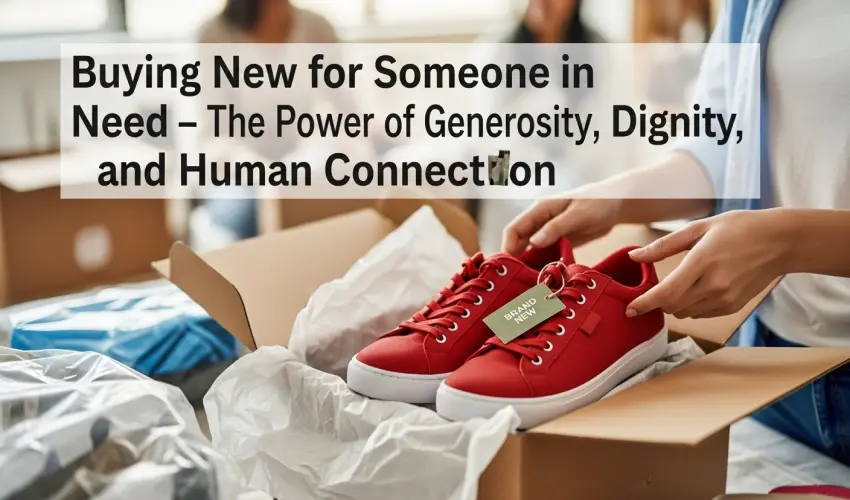Buying New for Someone in Need: The Power of Generosity, Dignity, and Human Connection
Discover the profound difference between donating used items and buying something new for someone in need. This guide explores how intentional acts of kindness restore dignity, offer hope, and create a powerful human connection.
Key Takeaways
-
Buying new items for someone in need offers not just utility but restores dignity, self-worth, and emotional well-being.
-
New gifts symbolize equality, care, and intentional kindness, sending a message that the recipient is truly valued.
-
The act creates a two-way transformation: it uplifts the receiver and profoundly impacts the giver.
-
Providing new things instead of used goods is about offering respect, not just relief.
-
Small acts like buying a new coat, school supplies, or a toy can create lifelong memories and hope.
Introduction: More Than Just a Gift
Imagine being a child who's never owned a brand-new pair of shoes. Imagine a single mother receiving hand-me-downs for years and suddenly being handed a freshly purchased winter coat, tags still on. The warmth isn’t just in the fabric; it’s in the message: "You matter enough to deserve something new."
Buying something new for someone in need is more than a simple act of charity. It’s a declaration of dignity, a sign of intentional empathy, and a gesture that can leave lasting emotional footprints.
Why "New" Matters: A Message Beyond the Material
When people donate, the instinct is often to give what’s no longer useful. While these gifts are appreciated, there’s a silent difference between "you can have what I no longer need" and "I bought this just for you."
New items carry powerful messages:
“You are worth this investment.”
“Your need is real and valid.”
“You deserve joy, not just survival.”
“You are seen.”
For someone struggling, receiving something new is often the first time in a long time they’ve felt equal, included, or prioritized.
Restoring Dignity Through Giving
Dignity is the soul of giving. Used items, while helpful, often come with unspoken narratives of lack. When someone receives something new:
-
They don’t feel second-best.
-
They feel respected.
-
They feel chosen, not pitied.
For children, especially, new things can shape self-perception. A new backpack, a new soccer ball, a new set of crayons—these moments matter because what we give reflects what we believe others deserve.
The Profound Impact on the Recipient
The gift of something new can have emotional ripples beyond what the eye can see.
-
It restores confidence. A man with a new interview suit walks taller. A child with new school supplies feels less anxious in class.
-
It builds trust and hope. A brand-new item can represent a turning point, a reminder that someone believes in their future.
-
It provides emotional healing. A thoughtful new gift can begin to heal wounds caused by years of neglect or hardship. It says: “You are not forgotten.”
How Giving Transforms the Giver
Buying something new for someone in need doesn’t just bless them; it transforms the giver, too.
-
You become more intentional. You shift your mindset from charity to connection, asking, "What would bring this person joy?"
-
You develop deeper empathy. Walking through a store thinking about someone else's needs helps you see the world differently.
-
You feel a unique joy. Giving your best to someone else is a powerful and fulfilling experience.
Real-Life Stories That Inspire
New Shoes, New Confidence
At a shelter, a volunteer noticed a shy boy who whispered that he needed “shoes that aren’t broken.” The volunteer returned the next day with a brand-new pair of sneakers. The boy smiled for the first time in days and immediately joined a game of soccer with the other kids.
A Gift Box of Dignity
A group of college students assembled care packages for homeless women with not just hygiene items, but brand-new lip balms, lotions, and scarves. One woman opened hers and cried, “I feel human again.”
How to Start Giving New (Even on a Budget)
Giving new doesn’t mean spending excessively. It means giving thoughtfully.
-
Choose One High-Impact Item. Instead of a bag of used clothes, consider buying one new hoodie, scarf, or book.
-
Join or Start a Community Drive. Many non-profits run seasonal campaigns (e.g., "New Shoes for School," "Holiday Toy Drive") where your single new item makes a massive difference.
-
Use Your Skills. If you’re a creator or crafter, you can make new items like blankets, art, or knitted caps.
-
Team Up. Pool resources with friends or coworkers. This makes it easier to buy new items and shares the joy of giving.
Partnering with Organizations That Prioritize Dignity
Look for groups that focus on new and dignity-centered giving. These organizations often:
-
Ask for specific, new items.
-
Focus on presentation (gift wrapping, personalization).
-
Work directly with schools, shelters, or hospitals to identify real needs.
Why New Often Beats Used
While used items are valuable, there are situations where new is crucial:
-
Intimate items: Underwear, hygiene products, socks, and bedding.
-
Gifts for children: Every child deserves the joy of opening something that’s brand-new and just for them.
-
Emergency response: In a moment of trauma or crisis, new goods signal safety, care, and a sense of control.
Conclusion: A New Standard for Compassion
Buying something new for someone in need isn’t about showing off. It’s about showing up with respect, love, and intention. It tells the recipient:
“You are not a burden. You’re worthy of joy. You are remembered, not because of what you lack, but because of who you are.”
So next time you're out shopping, think: Who could use something new, not just because they need it, but because they’re worth it?
Then buy it. Wrap it. Deliver it. And watch dignity bloom.
Join the conversation
Share how this story resonates with your journey. We feature standout reflections in our newsletter.

